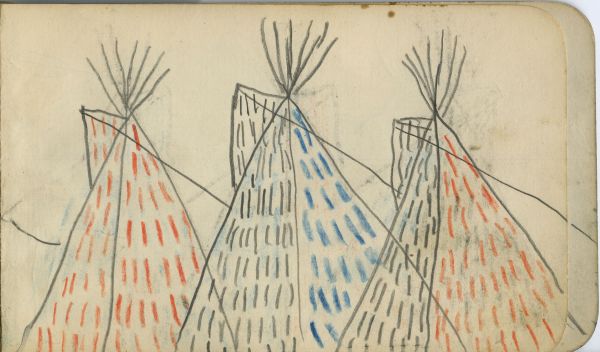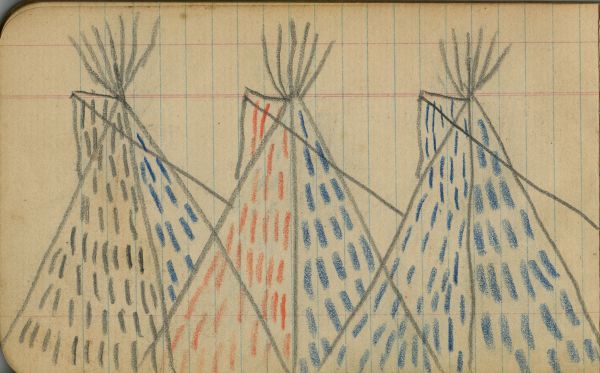CAMP SCENE: Six Tipis Decorated with Red, Blue, and Black Vertical Dashes
Ethnographic Notes
Drawn upside down in ledger. The two pages complement each other, as the six identical tipis vary in color only. When dashes appear on the ground, they indicate steps. Here they could be decoration only. Blue and black are feminine, and the balance of masculine red appears in the composition of both these plates. Michael Cowdrey writes about the red and black dynamism: "Red symbolizes the sun, the phallus, and all things masculine; black denotes night and death, the womb, and all things feminine" (1999: 46). Imre Nagy also discusses the constantly shifting balance between the two spheres (1994: 40). Candace Greene notes the syntactical contrasts between blue (or black) and red (1985: 67). Throughout these ledgers, the interaction of red (or orange) and blue (or black) create a dynamic theme of interaction between the two realms. p. 2 CAMP. Three Tipis Decorated with Red, Blue, and Black Dashes. Three tipis stand in a row, overlapping and filling the page. The page is small, 3 1/2 by 5 1/2 inches, so this overlapping and X-ray vision through the front object to the one behind makes it possible to use all the space. Seven poles are drawn in the left tipi, and six on the two others, gathered at the smoke hole. The tent flaps are all open. Each tipi has a line bisecting it vertically down the middle. Vertical dashes decorate the tents--black (lead pencil) on the left half and blue on the right half of the first; orange on the left half and blue on the right half of the second; and all blue dashes on the third. Media: Lead pencil outlines with details of lead pencil and orange, and blue. p. 3 CAMP. Three Tipis Decorated with Red, Blue, and Black Dashes Three tipis stand in a row, overlapping and filling the page. Like the three tipis on the preceding page, X-ray vision makes it possible to see through the overlapping sides. Six poles are drawn in the left tipi smoke hole, and six on the second, and seven on the third (mirror image to the page before). The tent flaps are all open. Each tipi has a line bisecting it vertically down the middle. Vertical dashes decorate the plain background of the tipis, all orange on the left tipi; black (lead pencil) on the left half and blue on the right half of the second; and black (lead pencil) dashes on the left half and red (orange pencil) on the right half of the third tipi. Media: Lead pencil outlines with details of lead, orange, and blue
Comment (4) All Comments For This Ledger
-
Ross Frank
9/7/12, 1:42 AMThat is a wonderful comment and idea. A photo of such a tipi cover would be quite useful.
-
our sainsburys
12/4/18, 1:24 PMsd
-
Denise Low
1/21/17, 7:59 PMI have seen canvas, but not denim, and this is 1878 or before. I'd like to see more about use of cloth in tipis. In IT I believe that had a mix of canvas and hide tipis. Anyone else?



Linea Sundstrom
9/4/12, 4:00 PM
Wondering if these are canvas or denim tipi covers in a print fabric. Sort of odd how similar they all are.